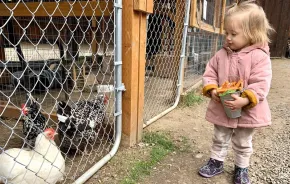
Photo:
Pacific Northwest Ballet School students in Bruce Wells’ Hansel & Gretel, which PNB is presenting through March 25, 2017.
Each spring, the hard-working students of Pacific Northwest Ballet School put on a performance designed to captivate an audience more accustomed to Nickelodeon than fine arts. For the first time since 2013, they are performing Hansel and Gretel, a short children’s ballet based on the classic fairy tale. Apart from the narrator and the witch (danced by former PNB dancer Ariana Lallone) all the performers are children and teens in the PNB School. Some of the dancers you see at this annual recital will be joining professional corps de ballet around the country shortly. (In fact, PNB audiences have already seen some of them on the professional stage – Joh Morrill, who danced Hansel on Sunday, was the 13-year-old Prince in the 2015 debut of George Balanchine’s The Nutcracker.)
Designed to showcase the dancers’ development, the choreography by Bruce Wells serves as a perfect introduction for audiences to classical ballet technique. The fairly straightforward “March of the Gingerbread Men” contrasts with the freer movement of the witch’s cats. Ariana Lallone as the stepmother and the witch does a fair bit of character acting while Hansel and Gretel use more traditional pantomime. The older students demonstrate pointe work, lifts and some killer fouettes (spinning). The main difference between Hansel and Gretel and a professional company performance is the fact that the fact that it has a narrator and the shorter length of the performance.

All three of the 8-year-olds who attended with me said they had no trouble following the story (which two of them claimed to be unfamiliar with!) and said the narrator helped them understand when the dancing was moving the plot along and when it was just supposed to be pretty. They all enjoyed the extended sequences when dancers represented sparkling stars or fluttering birds, and were in no hurry to get back to the story line. In fact, all three girls were literally on the edge of their seats for most of the performance, and cited the birds as their favorite part. (The 5-year-old boy sitting in front of us was almost as fascinated as they were.)
Parents should know
There is nothing scary in this production, and there is little need for preparation. The dance is specifically designed to be enjoyed by audiences unfamiliar with ballet. This is a good opportunity to talk about and practice good audience behaviors, but one of the nice things about a family performance is that no one minds the occasional crying baby or too-loud question mid-performance.
Temperament is more important than age in determining whether your child is ready for an hour-long ballet. Literally all ages from infants to grandparents attend the PNB School performance, and in nearly all cases the production holds their attention. With a narrator, a short runtime, activities in the lobby before the performance and during the intermission, cheaper-than-normal ticket prices, and an audience full of other children, Hansel and Gretel makes attending the ballet easy. You don’t even have to dress up, unless it’s for your family to do so. Seattle’s famously relaxed dress code is even more in evidence than usual at this production..
If you go...Where and when: Marion Oliver McCaw Hall, 321 Mercer Street, on the north edge of Seattle Center. The only remaining performance is Saturday, March 25 at 3:30 p.m. Arrive early to allow time for parking, collecting booster seats and getting settled. Tickets: Every family member must have a ticket, but at $23-$60, Hansel and Gretel tickets are less expensive than regular season performances. There are no bad seats at McCaw Hall – do not hesitate to buy the cheapest seats available. Tickets can be purchased online. Parking: The Mercer Garage is connected to McCaw Hall by a sky bridge. Rates vary depending on events at Seattle Center; plan for $15. Other pay lots in the neighborhood have similar pricing. Street parking is limited to 4 hours, and hard to come by. Tips: - Run time is one hour and 10 minutes, including a 15-minute intermission - Booster seats are available at no cost. - The concession stands are open during this production, but unless you pre-order intermission snacks before the show, you might still be in line when the bell rings for the second half. - Arts and crafts projects, dance classes and the instrument petting zoo begin in the lobby 60 minutes before show time. The instrument petting zoo continues during intermission.
|











